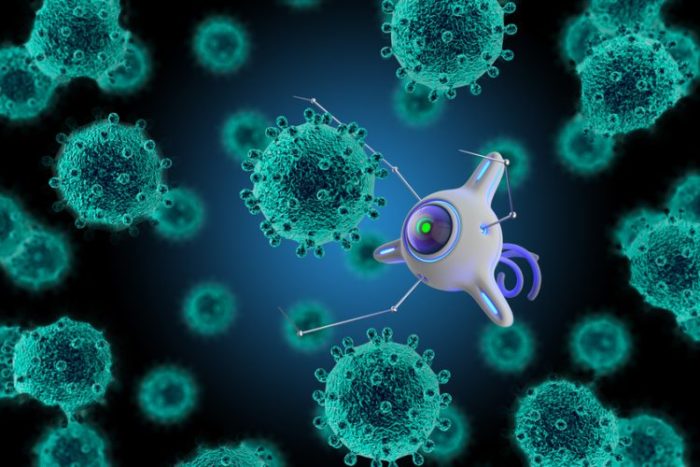Oct 20 2022
Biodegradable Medical Microbots
 Imagine injecting microscopic robots into a patient that then can be guided to a specific location in the body where they deliver drugs or stem cells for therapy. This technology is actually not far off. Researchers have been developing multiple types of tiny medical robots, and some have been used successfully in animals.
Imagine injecting microscopic robots into a patient that then can be guided to a specific location in the body where they deliver drugs or stem cells for therapy. This technology is actually not far off. Researchers have been developing multiple types of tiny medical robots, and some have been used successfully in animals.
The simplest form of such microbots is a tiny sphere that contains magnetic nanoparticles and has a nanoscale structured surface. The surface allow for stem cells to bind so that they can be delivered to the desired location. The movement of the microbots is controlled by an external magnetic field acting on the nanoparticles. Essentially they are a delivery system, and when their task is done they are biodegradable so they break down and are eliminated by the usual mechanisms. Microbots can also be designed to be infused with drugs to deliver to their target.
There are numerous applications for this technology. One obvious one is the targeting of tumors. Effective anti-cancer treatments are often limited by their toxicity, but if they can be delivered directly to a tumor then they are both more effective and less toxic to healthy tissue. Stem cells can also be delivered, and they can also be engineered to kill cancer cells. They could also be engineered to produce hormones or chemical, or they could support other cells or even take up function themselves.
Other microbots can be self-propelled, including: “tailor-made motile bacteria and tiny bubble-propelled microengines to hybrid spermbots.” Another approach combines algae cells and nanoparticle to produce a microbot that can swim around specific organs, such as the lungs. This was tested in pneumonia in mice, and the microbots were able to swim around and kill the infecting bacteria.
One limiting factor of this technology is that it can take a long time to manufacture the microbots, but we are seeing progress on that front as well. The microbots with the magnetic nanoparticles are currently created by two-photon lithography, which is a slow process and often made more difficult by the presence of the nanoparticles which can block the lasers used to form the bots out of resin. One team of researchers may have solved this problem, however, “by flowing a mixture of magnetic nanoparticles and biodegradable gelatin methacrylate, which can be cured by light, onto the microfluidic chip.” With this method they can produce the microbots 10,000 times faster, at a rate of about 100 per minute.
We are seeing steady and rapid incremental advances in this technology, along multiple lines of development, and with demonstrable progress. Tricky technology like this always takes longer than it seems at this stage, but it seems likely that within 10-20 years we will be seeing significant medical applications. What is the ultimate potential of this technology?
The low-hanging fruit are the applications already discussed, using the microbots as delivery systems for drugs and stem cells. The stem cells themselves can have numerous functions and therefore applications. Microbots can also be used to directly target and destroy cancer cells and invading bacteria, and possibly even viruses. That application essentially makes them an artificial immune system that can be pre-targeted against a specific cancer or infection and then injected into a sick patient.
As the technology matures I can imagine more complex functions. Microbots could be designed to crawl along the inside of blood vessels, stripping away cholesterol and preventing or reversing atherosclerotic disease. As long as they were small enough to get through capillaries, they should not cause any clotting problems, but of course that would be the primary safety concern that would have to be studied.
Diagnostically, microbots could sample the environment inside specific tissues and indicate that in some way. Perhaps they light up when they encounter cancer cells, and this can be picked up on imaging. We already use tiny cameras in the GI system, but even smaller optics connected to microbots could image other tissues, each one sending a single snap shot through a burst of radio waves, for example. This could serve as a minimally invasive biopsy.
The holy grail for medical microbots, however, I think would be direct tissue repair. Perhaps microbots could be fitted with a tip that can heat up briefly, enough to cauterize a bleeding blood vessel. They could “suture” tissue in some way. Beyond repair is actual regeneration, but that would likely take combing the microbots with stem cells. Microbot and stem cell technology will hopefully progress together for these applications.
Beyond the obvious applications, the details get more difficult to predict. It’s difficult to reproduce the cleverness and creativity of thousands of experts over the coming decades. Hopefully people smarter than me will think of some “killer apps” for this technology I have not thought of. In any case, this is definitely a technology to keep an eye on.






